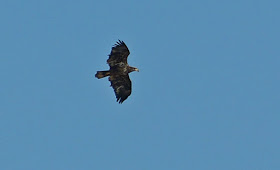Everyone recognizes our national symbol, the Bald Eagle, right? Most people know that they were on the endangered species list for many years. Before European settlers arrived in North American, an estimated half-million Bald Eagles may have lived along every large river and concentration of lakes within North America, nesting in forty-five of the lower forty-eight states. Their numbers began to drop as they had to compete with people for territory and food through the 1800's. The pesticide DDT killed huge numbers of Eagles and other birds by making their eggs too thin to survive incubation.
Bald eagles were officially declared an endangered species in 1967 in all areas of the United States south of the 40th parallel, under a law that preceded the Endangered Species Act of 1973. On July 4, 1976, the US Fish and Wildlife Service officially listed the bald eagle as a national endangered species. By June 2007, they were officially removed from that list, having been re-introduced into their old territories by hacking, or releasing young birds, in appropriate areas. When the young birds reach the age of reproduction, they return to the area where they fledged to raise their own young. The number of nesting pairs in the lower 48 United States increased 10-fold, from less than 450 in the early 1960s, to more than 4,500 adult bald eagle nesting pairs in the 1990s. In the Southeast, for example, there were about 980 breeding pairs in 1993, up from about 400 in 1981. The largest concentrations were in the states of Florida and Louisiana. Today, there are an estimated 9,789 nesting pairs of bald eagles. In Kentucky, we have an estimated population of 100 breeding pairs, including two nesting sites in Jefferson County.
Their beaks are dark as well as their feathers as youngsters, and as they mature, you can see the beaks and legs changing color too.
They love the open snags at the top of an old bald cypress tree for an "eagle's eye" view of the lake. Reel Foot State Park offers eagle viewing weekends in January. Reel Foot Lake is home to one of the largest wintering populations of eagles in the country. During the peak season (Jan.-Feb.) there can be as many as 200 eagles wintering on Reel Foot. The three Kentucky State Parks near Land Between the Lakes offer eagle weekend tours as well.
U.S. Fish and Wildlife personnel will often climb up into eagle nests (a dangerous move) to band the young eaglets before they fledge. Kentucky's Dept of Fish and Wildlife has attached satellite transmitters to several bald eagles to track their movements. The eagles wear a 70g solar-powered GPS-PTT satellite transmitter, attached externally, like a backpack with a Teflon harness. Solar panels recharge the transmitter's battery and we hope to receive three-five years of tracking data from each of these birds. The transmitter will not affect the eagle’s ability to fly, forage, or breed. Each transmitter, or tracking device, will allow KDFWR to follow the bald eagle’s movements and will provide information on the dispersal, home range, migration, roosting and foraging patterns, as well as, the survival of each eagle. In examining the photos I took, I saw that one of our birds had a radio transmitter on his back. (click to enlarge the photo for a closer view). Dave Haggard, long time eagle expert and our guide yesterday, said he would see if he could track this down.
Chief Paduke is the adult eagle (no, this photo isn't the Chief, but a bird I saw yesterday) currently being tracked in Kentucky, but the maps indicate that he's staying pretty much around the Paducah area. "Chief Paduke" was captured using a rocket-net at Ballard Wildlife Management Area (WMA) in western Kentucky on April 30, 2012. Chief is an adult male (at least 5 years old) and is known to nest on Ballard WMA. But Chief was already banded when captured! He had been rehabilitated in 2010 after he was illegally shot, which injured his wing. The Kentucky Department of Fish and Wildlife Resources (KDFWR) captured Chief after a landowner reported seeing an injured eagle and took him to Raptor Rehabilitation of Kentucky. After recovering from surgery, Chief was released in his nesting territory in late summer 2010. WOW! I was volunteering at Raptor Rehab that summer, but didn't realize one of our birds was being tracked! Too cool!







No comments:
Post a Comment